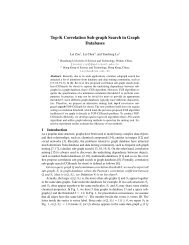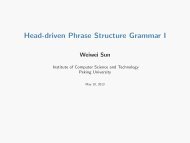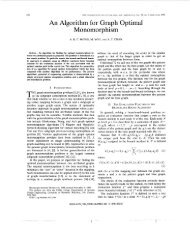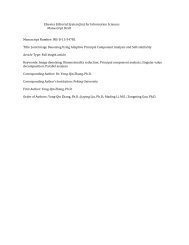PDF (1MB) - QUT ePrints
PDF (1MB) - QUT ePrints
PDF (1MB) - QUT ePrints
Create successful ePaper yourself
Turn your PDF publications into a flip-book with our unique Google optimized e-Paper software.
16 · Alsayed Algergawy et al.<br />
Fig. 8: The context of an object.<br />
These similarity measures are then aggregated using an aggregation function, such as<br />
the weighted sum, to produce the complex similarity between two objects.<br />
CSim (OP 1 , OP 2 ) = Combine C (Child(OP 1 , OP 2 ),<br />
Leaf(OP 1 , OP 2 ),<br />
Ancestor(OP 1 , OP 2 ))<br />
where Child(OP 1 , OP 2 ), Leaf(OP 1 , OP 2 ) and Ancestor(OP 1 , OP 2 ) are the similarity<br />
functions that compute the child, leaf, and ancestor contexts between the two objects, respectively,<br />
and Combine C is the aggregation function to combine the similarity values.<br />
The schema matching community, in general, classifies approaches for XML schema<br />
matching (element-level) into two main approaches [Rahm and Bernstein 2001], as shown<br />
in Fig. 6.<br />
—Schema-based Approaches. These approaches only consider schema information, not<br />
instance data. Schema-based approaches exploit the object features and their relationships.<br />
These properties are then exploited using either individual matchers or combining<br />
matchers in a rule-based fashion to determine semantic similarity among schema elements.<br />
An individual matcher exploits only one type of element properties in a single<br />
matcher, while a combining matcher can be one of two types: hybrid matchers, which<br />
exploit multiple types of element properties in a single algorithm and composite matchers,<br />
which combine the results of independently executed matchers. The element level<br />
similarities are then aggregated to compute the total similarity between schemas [Do and<br />
Rahm 2002; Melnik et al. 2002; Giunchiglia et al. 2007; Bonifati et al. 2008; Saleem<br />
et al. 2008; Algergawy et al. 2009]. They are easy to implement and do not need to be<br />
trained before put in use.<br />
—Instance-based Approaches. These approaches consider data instances as well as schemabased<br />
information. The instance-level data give important insight into the contents and<br />
meaning of schema elements. The main advantage of these approaches is that they can<br />
empirically learn the similarities among data relying on their instance values. Hence,<br />
many learner-based schema matching systems have been developed to determine the<br />
element-level similarity [Li and Clifton 2000; Doan et al. 2004]. These systems depend<br />
largely on pre-match phases such as the training phase using unsupervised learning in<br />
SemInt [Li and Clifton 2000], using machine learning in GLUE [Doan et al. 2004], or<br />
ACM Computing Surveys, Vol. , No. , 2009.












